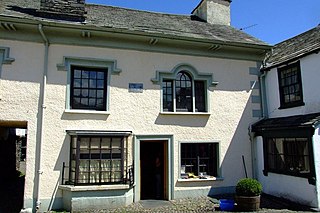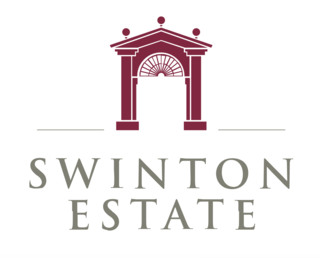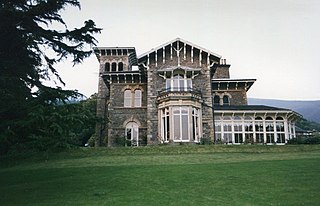
Lingholm is a country house just outside Portinscale in Cumbria, England.

Lingholm is a country house just outside Portinscale in Cumbria, England.
The house was built in 1871–1875 for Lt-Col James Fenton Greenall (1834–1899), of the Greenall brewing family, Commanding Officer of the 9th Lancashire Rifle Volunteers, at a cost of £15,700 by Alfred Waterhouse. [1] In 1900 it was purchased by the family of George Kemp, 1st Baron Rochdale. [2] They commissioned Bertram Symons-Jeune to design the water garden at Lingholm. Between 1885 and 1907, Beatrix Potter spent her summer holidays at Lingholm, where she wrote some of her best-known stories. [3] Beatrix credited The Lingholm Kitchen Garden as her original inspiration for Mr McGregor's Garden in The Tale of Peter Rabbit . She also wrote The Tale of Squirrel Nutkin and the first draft of The Tale of Mrs Tiggy-Winkle whilst staying at Lingholm. [4]
During World War I, the house was used as a hospital for wounded officers. [1]
As a result of Beatrix Potter's connection and its unique design by a well respected architect, Lingholm was listed Grade II on the National Heritage List for England in 2013. [5] [6]

Helen Beatrix Potter was an English writer, illustrator, natural scientist, and conservationist. She is best known for her children's books featuring animals, such as The Tale of Peter Rabbit, which was her first commercially published work in 1902. Her books, including 23 Tales, have sold more than 250 million copies. An entrepreneur, Potter was a pioneer of character merchandising. In 1903, Peter Rabbit was the first fictional character to be made into a patented stuffed toy, making him the oldest licensed character.

Osborne House is a former royal residence in East Cowes, Isle of Wight, United Kingdom. The house was built between 1845 and 1851 for Queen Victoria and Prince Albert as a summer home and rural retreat. Albert designed the house himself, in the style of an Italian Renaissance palazzo. The builder was Thomas Cubitt, the London architect and builder whose company built the main facade of Buckingham Palace for the royal couple in 1847. An earlier smaller house on the Osborne site was demolished to make way for the new and far larger house, though the original entrance portico survives as the main gateway to the walled garden.

Temple Newsam is a Tudor-Jacobean house in Leeds, West Yorkshire, England, with grounds landscaped by Capability Brown.

Peter Rabbit is a fictional animal character in various children's stories by English author Beatrix Potter. A mischievous, adventurous young rabbit who wears a blue jacket, he first appeared in The Tale of Peter Rabbit in 1902, and subsequently in five more books between 1904 and 1912. The six books by Potter featuring Peter Rabbit have sold over 150 million copies. Spin-off merchandise includes dishes, wallpaper, painting books, board games and dolls. In 1903, Peter Rabbit was the first fictional character to be made into a patented stuffed toy, making him the oldest licensed character.

Eaton Hall is the country house of the Duke of Westminster. It is 1 mile (2 km) south of the village of Eccleston, in Cheshire, England. The house is surrounded by its own formal gardens, parkland, farmland and woodland. The estate covers about 10,872 acres (4,400 ha).

Hill Top is a 17th-century house in Near Sawrey near Hawkshead, in the English county of Cumbria. It is an example of Lakeland vernacular architecture with random stone walls and slate roof. The house was once the home of children's author and illustrator Beatrix Potter who left it to the National Trust. It is a Grade II* listed building. It is open to the public as a writer's house museum, shown as Beatrix Potter herself would have known it.

Blaise Castle is a folly built in 1766 near Henbury in Bristol, England. The castle sits within the Blaise Castle Estate, which also includes Blaise Castle House, a Grade II* listed 18th-century mansion house. The folly castle is also Grade II* listed and ancillary buildings including the orangery and dairy also have listings. Along with Blaise Hamlet, a group of nine small cottages around a green built in 1811 for retired employees, and various subsidiary buildings, the parkland is listed Grade II* on the Register of Historic Parks and Gardens of special historic interest in England.

Muncaster Castle is a privately owned castle overlooking the River Esk, about a mile east of the west-coastal town of Ravenglass in Cumbria, England. It is recorded in the National Heritage List for England as a designated Grade I listed building.

The Beatrix Potter Gallery is a gallery run by the National Trust in a 17th-century stone-built house in Hawkshead, Cumbria, England. It is dedicated to presenting original book illustrations by children's author Beatrix Potter.

The Tale of Squirrel Nutkin is a children's book written and illustrated by Beatrix Potter and first published by Frederick Warne & Co. in August 1903. The story is about an impertinent red squirrel named Nutkin and his narrow escape from an owl called Old Brown. The book followed Potter's hugely successful The Tale of Peter Rabbit, and was an instant hit. The now-familiar endpapers of the Peter Rabbit series were introduced in the book.

The Swinton Estate is a large privately owned estate in North Yorkshire, England. It comprises some 20,000 acres (8,100 ha) of countryside in the Nidderdale Area of Outstanding Natural Beauty, extending 10 miles (16 km) west from the River Ure near Masham. The estate includes Swinton Park, the seat of the Danby family and of the Cunliffe-Lister family, an English country house in Swinton near Masham. It is set in 200 acres (81 ha) of parkland, lakes and gardens. The house is a Grade II* listed building, and now operates as the 42-bedroom Swinton Park Hotel.

Rydal Hall is a large detached house on the outskirts of the village of Rydal, Cumbria, in the English Lake District. It has an early nineteenth-century front facade, but includes some earlier fabric.

Walton Hall is a country house in Walton, Warrington, Cheshire, England. It is recorded in the National Heritage List for England as a designated Grade II listed building. The hall and its surrounding garden and grounds are owned and administered by Warrington Borough Council.

Graythwaite Hall, in Ulverston, Cumbria in the Lake District of England is the home of the Sandys family.

Newlands Church is a 16th-century church situated less than 500 metres west of the hamlet of Little Town, Cumbria, England in the Newlands Valley of the Lake District. Its exact date of origin is unknown, but a map of 1576 shows a "Newlande Chap." on the site.

Little Town is a hamlet in the civil parish of Above Derwent, in the Allerdale district of Cumbria, England. It is in the Workington constituency of the United Kingdom Parliament. Prior to Brexit in 2020 it was part of the North West England constituency of the European Parliament.

Dalemain is a country house around 5 miles south-west of Penrith in Cumbria, England. It is a Grade I listed building. Dalemain is part of the Lake District UNESCO World Heritage Site.

Underscar Manor is a country house at Underskiddaw in Cumbria. It is a Grade II listed building.
Keswick is a civil parish and a town in the Cumberland unitary authority area of Cumbria, England. It contains 51 listed buildings that are recorded in the National Heritage List for England. Of these, one is listed at Grade I, the highest of the three grades, three are at Grade II*, the middle grade, and the others are at Grade II, the lowest grade. The parish includes the town of Keswick and the surrounding countryside, and part of Derwentwater, including Derwent Isle. Most of the listed buildings are houses, shops and cottages, and associated structures in the town. The other listed buildings include churches, public houses, hotels, bridges, a former Sunday school, a former railway station, a monument, a war memorial, and a former magistrate's court and police station. The listed buildings on Derwent Isle are a large house and a former chapel.

Gwaenynog is a small estate about 1 km (0.62 mi) to the south-west of the town of Denbigh, Wales. Its origins are mediaeval when it was built as a house for the Myddelton family. The Myddeltons claimed descent from Rhirid Flaidd, of the House of Cunedda, hereditary Kings of Gwynedd. Anglicising themselves and their name after the conquest of Wales, they thrived as prominent local landowners and politicians. Basing themselves ultimately at Chirk Castle, they served as receivers of Denbigh, governors of its castle and as members of parliament for Denbighshire and Denbigh Boroughs.